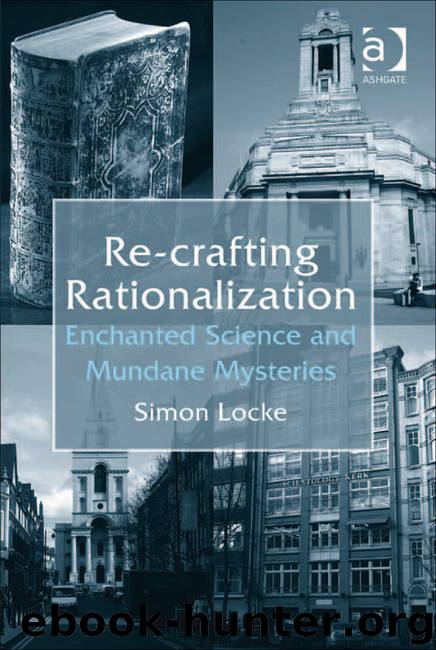Re-crafting Rationalization by Locke Simon

Author:Locke, Simon.
Language: eng
Format: epub
Tags: Enchanted Science and Mundane Mysteries
Publisher: Taylor & Francis (CAM)
Published: 2011-02-28T16:00:00+00:00
From Realistic Magic to Magical Realism
Thus, the pursuit of structural continuity has led to efforts to establish some form of transcendent coherence on a grander scale and it is here that the ‘rationalization of the irrational’ most fully emerges. There has been to this broadly a three-part development: first, the emergence of ‘cosmic’ level characters, powers and storylines taken to define a basic set of constituent elements of a given superhero universe; second, the attempt to systematize a given universe by establishing an order between the cosmic powers and their relationship to the ‘ordinary’ superheroes; third, the treatment of a superhero universe as reality itself, thereby reversing the move from science ‘fact’ to science ‘fiction’ and doing so on the grounds that the ‘magical’ constitution of the fantasy world is the underpinning of reality, that in other words reality is magic explicitly understood as symbolization. This is exactly what Whitehead anticipated as the next stage in the abstraction of the charismatic, but it can be more fully understood as an outcome of the workings of mundane reasoning constructing coherence through the documentary method of interpretation in the context of a culture that incorporates both the scientific and the magical as available resources and means of argumentation.
’Cosmic’ characters emerged out of ‘hierarchical’ continuity. In general, this refers to the relative positioning of superheroes in terms of their powers and moral character – crudely, who would win in a fight. In this respect, hierarchical continuity is an outcome of rationalization applied to serial continuity once characters began to cross-over and interact. In part, this follows from already established events as Reynolds (1992: 40) points out: if a hero has beaten a villain who then appears to beat another hero, then it follows that the first hero is more powerful than the second. However, source and type of powers have a bearing on this since some are more clearly matched than others. For example, the Marvel characters, the Hulk and the Thing are both super-strong, so their relative positioning is more straightforward than a character like Doctor Strange who has no super-strength but has all the otherworldly power of magic at his disposal. So, this raises the continuity puzzle of where magic fits in relation to ostensibly non-magical powers, which provides an impulse towards a more encompassing level that incorporates both.
This is also stimulated by another aspect of hierarchical continuity that Reynolds (1992: 41) calls the ‘extra effort, the moral determination to go on fighting even when apparently beaten.’ Even in the earliest Superman stories this was often the crucial turning point, when the apparently beaten hero would manage to overcome a final obstacle through some extra effort. But this contributed to a progressive, if somewhat haphazard inflation to Superman’s strength and abilities, so that while he began faster than a speeding bullet and able to leap tall buildings, he ended up faster than light and able to fly. This prompted continuity puzzles as to the extent of his abilities and questions about their ‘scientific’ possibility.
Download
This site does not store any files on its server. We only index and link to content provided by other sites. Please contact the content providers to delete copyright contents if any and email us, we'll remove relevant links or contents immediately.
| Coloring Books for Grown-Ups | Humor |
| Movies | Performing Arts |
| Pop Culture | Puzzles & Games |
| Radio | Sheet Music & Scores |
| Television | Trivia & Fun Facts |
The Social Psychology of Inequality by Unknown(2923)
Make Comics Like the Pros by Greg Pak(2839)
Stacked Decks by The Rotenberg Collection(2796)
Purple Hibiscus by Chimamanda Ngozi Adichie(2627)
The Queen of Nothing by Holly Black(2474)
The Art of Doom by Bethesda(2098)
Life of Elizabeth I by Alison Weir(2016)
Putin's Labyrinth(1949)
The Power of Habit: Why We Do What We Do in Life and Business by Charles Duhigg(1927)
Drawing Down the Moon by Margot Adler(1809)
Things Are What You Make of Them: Life Advice for Creatives by Adam J. Kurtz(1807)
Wall and Piece by Banksy(1771)
Agency by William Gibson(1764)
Art Of Atari by Tim Lapetino(1686)
Teaching to Transgress: Education as the Practice of Freedom (Harvest in Translation) by Bell Hooks(1675)
The Beatles Lyrics by Hunter Davies(1651)
Only What's Necessary: Charles M. Schulz and the Art of Peanuts by Chip Kidd(1633)
The Pin-Up Art of Bill Ward by Bill Ward(1558)
The Andy Warhol Diaries by Andy Warhol(1551)
